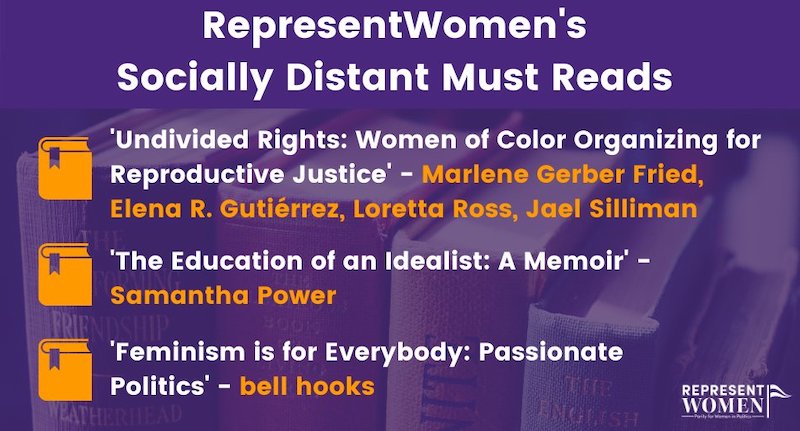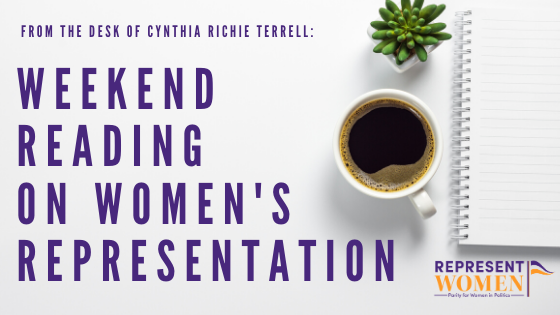
Weekend Reading on Women’s Representation is a compilation of stories about women’s representation in politics, on boards, in sports and entertainment, in judicial offices and in the private sector in the U.S. and around the world—with a little gardening and goodwill mixed in for refreshment!

One of the best parts of writing this blog each week is finding pieces that challenge paradigms and bring fresh energy to the push for women’s representation and equality. This article on Medium by Kristin Hull offers a great set of tools to help us all dismantle the patriarchy:
I used to give up wine or cocktails, and when I was younger, chocolate. With everything going on in our world, giving up alcohol or sweets seems so 2019. Last year in 2020 — and again this year — I am giving up the patriarchy for Lent.
This year my decision is more than symbolic. Women lost more than 5.4 million jobs in 2020. During the first 10 months of the pandemic, women — particularly women of color — have lost more jobs than men as industries that employ women have been hit the hardest. The #SheCession is, in itself, a national crisis. Further, women-owned businesses are suffering as we have seen women across the country step up to both provide care for elders, neighbors, as well as become homeschool teachers.
For those that are wondering, “What does that look like to give up the patriarchy?” (“How are you going to do that?” has been a common question), this is how am I going about this:
I am starting by recognizing that a male dominated system may have made some sense at some point, and perhaps even grew out of good intentions way back when. And yet the current dominance of one gender over another across every industry of our economy and within our largest institutions is not serving any of us well. Those of us that care about racial equity also recognize the interconnections and see that. So, as Marie Kondo suggests, I am releasing the male dominant system with gratitude for ways it may have served in the past, and discarding the patriarchy as it does not spark joy.
Recognizing all of the places where male dominance makes up the status quo is an important first step. From our state, federal and local governments, to agriculture and food production, to banking and financial institutions, to the boards of directors and C-suites of our tech start ups, to our largest companies, men (predominantly white men) are at the table, making most of the big decisions that affect all of us.
Men largely make up the candidate pool of executive searches, and once hired, they advance within companies more rapidly than others, and earn more on the dollar than women for the same positions. Men also make up the vast majority of Hollywood, both in speaking roles and behind the camera as film directors and executive producers, influencing the media landscape, determining what we see from their point of view.
And, in my job, as an asset manager, women and people of color combined, manage just 1.3% of the $70 Trillion financial industry. This means that white men are making decisions on which companies get investment and how funds are constructed 98.7% of the time.
Because the patriarchy is the water we swim in and the air we breathe, it’s going to take some small and large changes in consciousness and in our daily practices to progress toward more balance. Here below, I highlight some of the steps I am taking to change this lack of balance, and move us toward parity and equality.
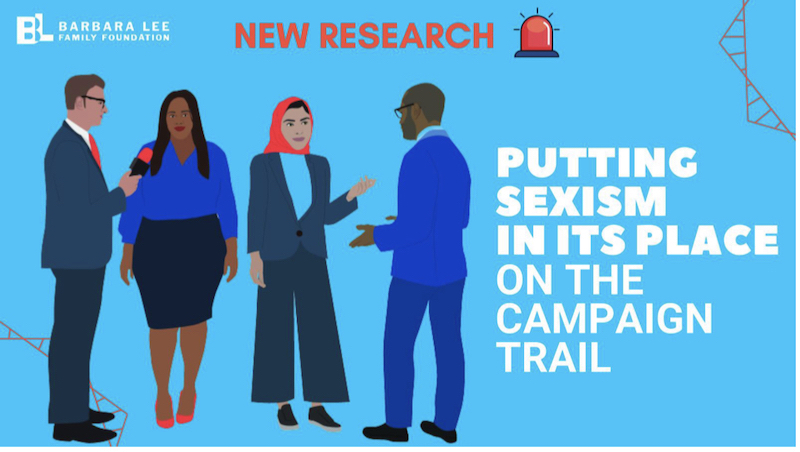
Our friends at the Barbara Lee Family Foundation released new research this week on how voters perceive sexism in politics:
Takeaways from Putting Sexism in Its Place on the Campaign Trail include:
A majority of voters acknowledge that women face sexism while campaigning, and broadly support women calling out their experiences of sexism.
Sexist incidents present women candidates with a leadership test they can pass, and voters do not believe candidates must choose to be electable or address sexism. Voters want a leader who is electable not despite the fact that she addresses sexism, but because she has the leadership skills to address it well.
There’s a longtime misperception that silence is a strong response when women experience sexism—this research suggests otherwise. Ignoring or being perceived as turning a blind eye to serious incidents of sexism can potentially result in blowback against women candidates because voters want to see strength and backbone.
Voters prefer a calm, confident, and professional response to a sexist situation from women candidates, rather than ignoring it or responding in anger. Among the large share of voters surveyed who want to see a woman candidate address a sexist incident, ignoring it or responding with anger diminishes their support for the candidate.
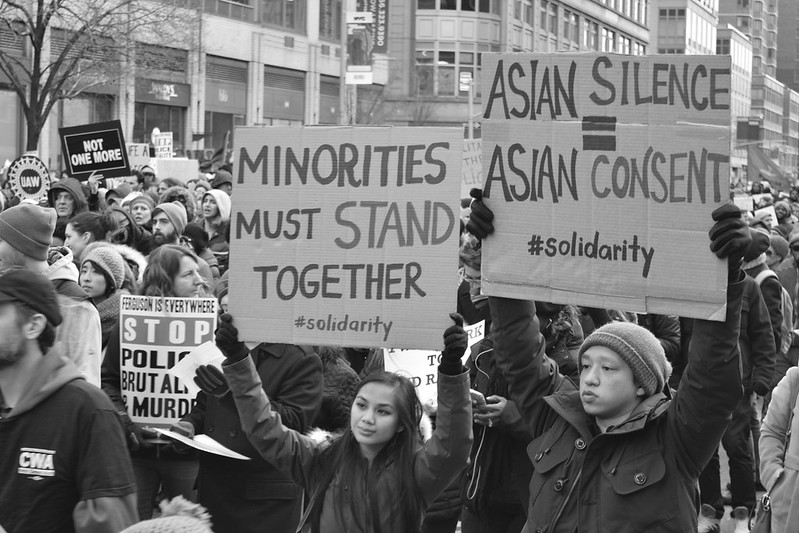
Fellow ReflectUS Coalition members Tiffany Gardner, Madalene Mielke, and Glynda Carr had a piece in Ms. about representation disparities in the Biden-Harris administration Cabinet and in Congress:
There are many reasons for women of color to celebrate after last November’s election cycle. We have certainly made some gains in positions of political leadership. Our nation elected the first Black, Asian and woman vice president. We also had a record number of women run and win U.S. congressional seats.
However, our national ReflectUS Coalition and its members know, one of the threats to achieving the success we’re all working toward is when politicians and other decision-makers believe the problem is solved. In the midst of our celebration, we cannot ignore some glaring gaps in representation that have intentionally excluded Black and Asian American and Pacific Islander (AAPI) women to the detriment of representation for us all.
For the first time in 20 years, since the first AAPI (Norman Y. Mineta) was appointed, no AAPI will serve as a Cabinet secretary. The distinction of a Cabinet secretary position means a greater voice at the table, and the ability to steer major policy decisions through leadership channels. America showed us that our country is ready for women of color to serve at the highest levels of government—yet this exclusion of AAPI appointments on the highest levels is a halt in the progress for the fastest growing community. AAPIs, despite challenges from increased hate incidents, disproportionate impact from the pandemic, and other barriers, managed to substantially increase their voices at the polls, yet are left unheard by the president.There hasn’t been a Black woman serving in the U.S. House of Representatives leadership since Representative Shirley Chisholm in 1981. Moreover, only two Black women—Carol Moseley Braun and Kamala Harris—have ever served in the U.S. Senate. When Vice President Kamala Harris resigned to take her place in the executive branch, that celebratory moment resulted in no Black woman replacing her in the Senate.
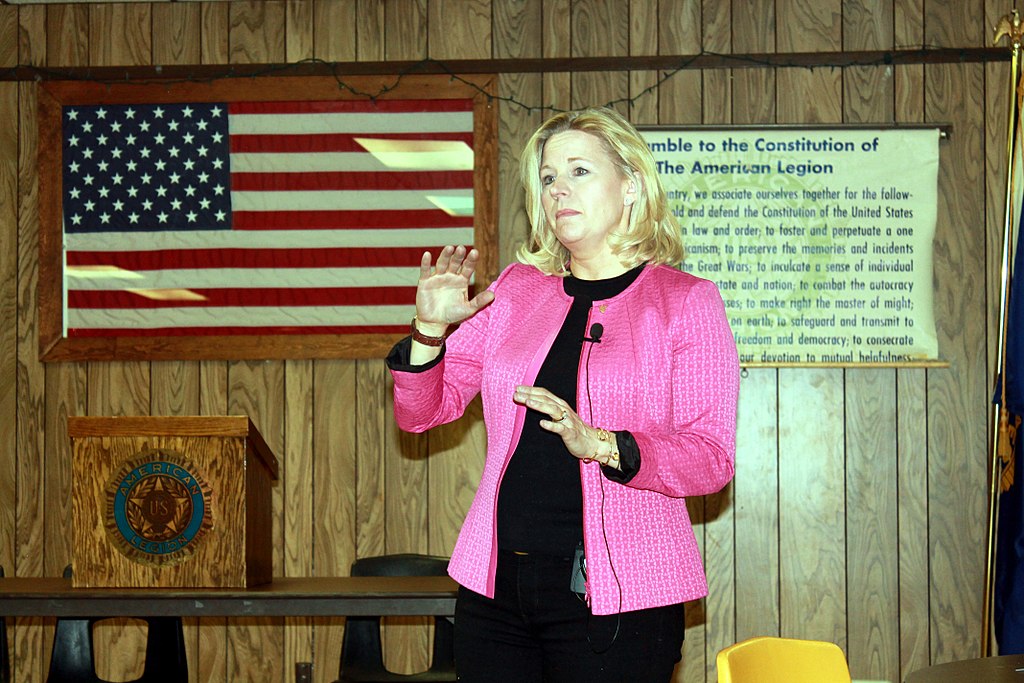
There were two stories this week about Republican women in Congress. This article by Catherine Wineinger in The Washington Post reports on leadership roles for the GOP women elected to the House of Representatives:
Despite facing a backlash for voting to impeach former president Donald Trump after the attempted Jan. 6 insurrection at the Capitol, Rep. Liz Cheney (R-Wyo.) held on to her seat as House Republican Conference chair. GOP lawmakers voted 145 to 61 by secret ballot in favor of Cheney. To many, this signaled a win for the establishment wing of the party. As Cheney has emphasized, Trump “does not have a role as a leader of our party going forward.”
But another congresswoman also made headlines last week. Rep. Marjorie Taylor Greene (R-Ga.) raised more than $1 million as the House voted to strip her of her committee assignments. The freshman representative who has expressed support for the extremist ideology QAnon has become one of the main faces of the Trump faction of the GOP. “The party is his,” Greene said of Trump at a recent news conference. “It doesn’t belong to anybody else.”
With little legislative power as the minority party in Congress, messaging is central to the GOP’s political strategy. As the party works to brand itself in this post-Trump era, my research tells us why we’ll probably continue to see women front and center.
While this article in Newsweek features some of the women who have helped increase the number of Republican women in Congress, including VIEWPAC CEO Julie Conway:
One reason Conway remains cautiously optimistic that the expanded ranks of Republican women in Congress will be a force for compromise and cross-party collaboration, even with their more conservative leanings, is because, until the past decade, that was generally true.
“When we were up to 25 Republican women in the House [in 2006], they met regularly with the Democratic women to see what they could work on together,” Conway recalls. “Women work better with women.”
A flood of studies back the notion that women lead more collaboratively and less confrontationally than men. Women in Congress sponsor and co-sponsor more bills than men, according to a study in the American Journal of Political Science. They also co-sponsor more bills with members of the opposite party as well as with members of their own gender, according to an analysis by Quorum.us, a public affairs analysis firm. They take more bipartisan fact-finding trips than men, attend hearings more frequently and, according to one 2011 analysis by researchers at Stanford and the University of Chicago, they bring an average of $49 million more back to their districts than men.
There has been quite a kerfuffle in Japan over comments about women talking too much in meetings and the role of women in decision making processes. Research from the Inter-Parliamentary Union and RepresentWomen indicates that women makeup just 9 percent of parliament in Japan.
According to this story in The Washington Post, the ruling Liberal Democractic Party has proposed allowing women to attend meetings, but to sit in silence:
When the leaders of Japan’s ruling Liberal Democratic Party meet, there are no women at the table. But the male-dominated elected body has a proposal to change that — by allowing five female lawmakers to sit in silence and watch the men work.
Toshihiro Nikai, 82, the party’s secretary general, told reporters Tuesday that the idea was to allow the party’s female members a chance to “look” at the top decision-making process, Reuters reported. They would then be able to submit comments following the meetings.
He did not say if any women had been consulted in devising the plan.
Japanese opposition politicians and social media users were quick to condemn the idea as part of the problem it would seek to address, not a solution.
Nikai made the proposal in the wake of another high-profile sexism row. Earlier this month, Yoshiro Mori, 83, then the head of the Tokyo 2020 Olympic organizing committee, resigned over comments he made demeaning women.
“When I see Mori’s comments described as a gaffe, it makes me irate because it is not a gaffe. It’s a verbal expression of national policy,” Minky Worden, director of global initiatives at Human Rights Watch, told The Washington Post following Mori’s resignation.
“This is an active policy of excluding women from positions that they are qualified to occupy and frankly would do a better job than men,” she added.
Japan has the largest gender gap among advanced economies recorded in the World Economic Forum’s gender parity assessment, ranking 121st out of 153 countries. Men continue to dominate the top spots across politics, sports and in other sectors, with only 5.2 percent of executive roles at Japanese companies held by women as of 2019.Reuters reported that earlier this week a group of Liberal Democratic Party female members asked Nikai to increase the representation of women in key party posts.
Japan’s former prime minister Shinzo Abe had set a goal of increasing the proportion of women leaders in government ministries and agencies, as well as private firms, by 30 percent by 2020. However, last June the government acknowledged the target was “impossible” and suggested 2030 instead.

A record number of women will hold state legislative leadership positions in 2021 according to research from the National Conference of State Legislatures that is discussed in this article in The Hill:
A record number of women are in state legislature leadership posts, with states like California, Maryland, Nevada and Vermont leading the pack.
Eighty-seven women nationwide were holding a leadership position in either a state House or state Senate at the start of this year’s legislative session, up from 72 in 2019, according to recent data from the National Conference of State Legislatures (NCSL).
The top ranks include positions like state House Speaker, state Senate president, Speaker pro tempore, Senate president pro tempore, majority leader and minority leader.
Of the six types of leadership positions that the NCSL analyzed, women hold four of those roles in six states — California, Maryland, Nevada, Oregon, Vermont and Washington. Ten states do not have any women serving in legislative leadership roles.
The number of Democratic women serving in leadership roles hit a record 64 this year.
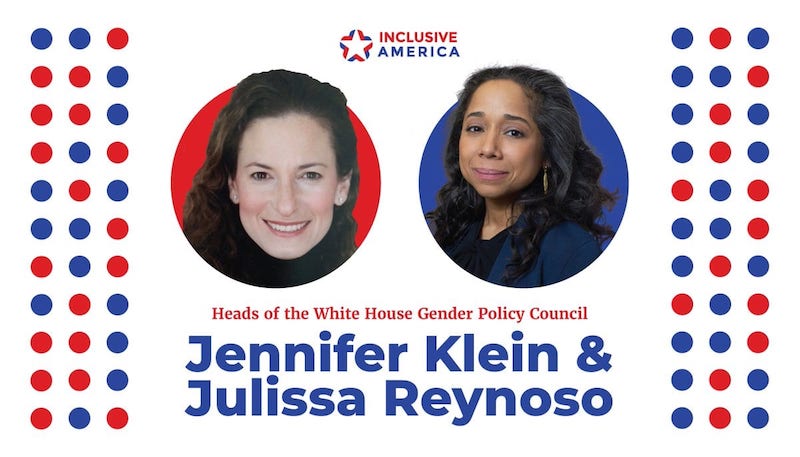
There were two important reads about the Biden/Harris Administration’s decision to rekindle the Gender Policy Council. This article by Kimberly Pike in Philanthropy Women posits that the group must have a dedicated budget for maximum impact across all sectors:
It has been roughly a month since the announcement from the Biden-Harris administration of its White House Gender Policy Council. As announced, the council is spearheaded by co-chairs, Jennifer Klein and Julissa Reynoso. During the Obama administration, a similar council called the White House Council on Women and Girls was created. Shortly after taking the presidency in 2016, Donald Trump disbanded that council. Now, Biden has reinstated a new council explicitly dedicated to working toward gender equality.
Many in the Democratic leadership heralded the new Council and its leaders as an important breakthrough. “Congratulations to Jen Klein, who’s long been by my side on domestic and global women’s issues, and Julissa Reynoso, a dynamo who served with me in the State Department,” said Hillary Clinton, in a post on Twitter regarding the Gender Policy Council leadership. “Great to have this team on the front lines fighting for women and girls everywhere.”
The announcement itself provides more details about what to expect from the council. Most importantly, the announcement dedicates the council to viewing all issues as gender related issues, including health care, economic security, racial disparities, and foreign policy, to name just a few.
While this piece on Refinery29 by Britni de la Cretaz provides a great overview of the purpose and potential of the Gender Policy Council. I agree with Hillary Clinton that it’s a good first step and hope that they also address barriers to women’s political participation along with other priorities:
President Joe Biden is showing just how seriously he takes the issue of gender equality. In an announcement this week, his administration plans to take a step that past administrations have tried before: instituting a Gender Policy Council. The difference is that this council, unlike the ones that came before it, will have teeth.
On Wednesday, the New York Times reported on Biden’s plan to revitalize the idea of having a council that’s focused specifically on issues of gender equity, something that was the brainchild of Hillary Clinton when she was First Lady. In 1995, then-President Bill Clinton announced an Interagency Council on Women, pegged to the 75th anniversary of women’s suffrage. That council was quietly disbanded by President George W. Bush, and subsequent administrations have worked on gender issues in a piecemeal way.
Biden is assuring that his council won’t follow that downward path. The Gender Policy Council is intended to correct the problem of “women’s issues” being seen as an afterthought by making several significant changes from how councils have worked in the past. How, exactly? For one thing, it will be located in the White House itself and every cabinet member will participate in it. Unlike councils past, which had people working on the issue on top of or in addition to their full-time roles, this council will have four full-time staff members (three working on policy and one handling administrative tasks).There will also be two co-chairs at the helm: Julissa Reynoso, former ambassador to Uruguay, and Jennifer Klein, former senior advisor to Hillary Clinton during her time as First Lady. The hope is that the staffing structure will make it more difficult for future administrations to dismantle the council.
“This is not just a council,” Klein told the New York Times. “It’s a plan to take a government-wide approach to gender equity and equality.” This will allow issues like the wage gap, gender-based violence, reproductive health, affordable childcare, and paid family leave to be integrated into larger policy conversations instead of having them siloed.
This council is also especially important now when the U.S. is in the midst of a pandemic that has devastated women economically and emotionally. “We need to maintain a laser focus on the particular needs and priorities for women and girls,” Klein told NPR. “If you look at last month’s job numbers, women have lost jobs in historic numbers, particularly women of color, and the caregiving burden is falling disproportionately on women.”
Women — women of color, in particular — lost 100% of the jobs in December 2020 and experts estimate it will take women at least a decade to recover from the workplace progress they’ve lost during the pandemic.
“The council is an absolutely critical first step,” Hillary Clinton told the New York Times. “It sends a very clear policy message to the rest of government that there is going to be constant attention paid to how important it is to integrate the kinds of concerns women are facing, especially post-pandemic.”
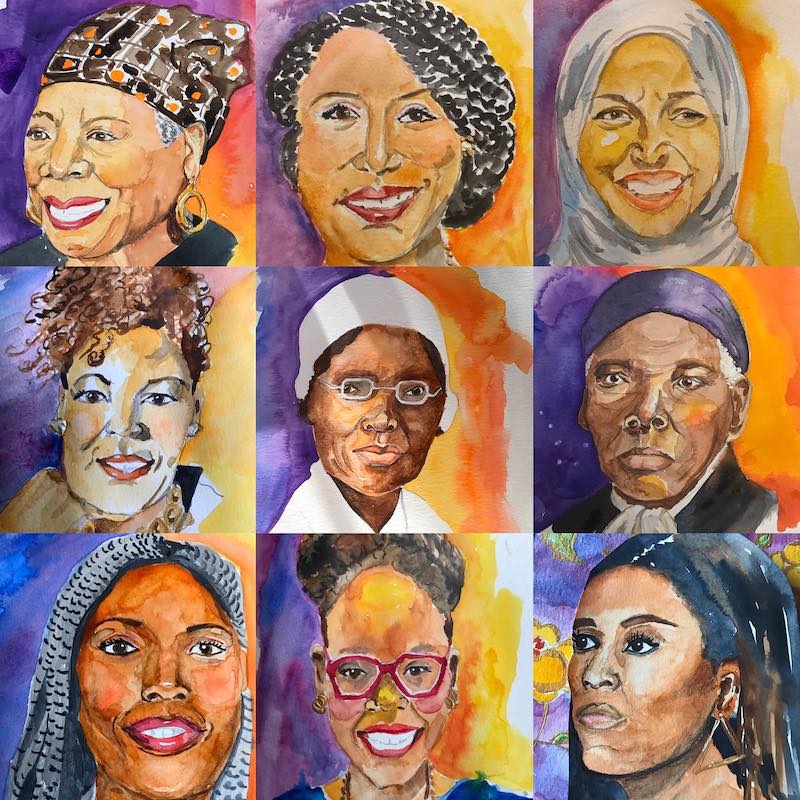

Alice Paul, noted women’s equality advocate and Quaker, graduate of Swarthmore College, and author of the Equal Rights Amendment wrote a column that was published in the Washington Times in 1923. We better get cracking if we are going to live up to her vision for women’s equality by 2023:
WOMEN WILL BE REAL EQUALS IN 2023
by Alice Paul
It will not require one hundred years to elect a woman President of the United States. Before 2023 I think we shall see a woman in the White House as chief executive of the nation and women will comprise half of the membership of Congress.
Throughout the ages the oppression of women, as a sex, has existed. Once having freed themselves from the restrictions to which they have so long submitted and that have made them subject creatures since the beginning of history, women will have the opportunity to revolutionize the world. If they use their opportunity the world a hundred years from now will be as if a new creation had been achieved.
Real Equals Soon.
My hope for women one hundred years from now is that they no longer will be subject to men in law or custom, that they no longer will be regarded or regard themselves as inferiors, that they no longer will be the governed half to society, but will participate equally with men in the direction of life.
My hope is that a hundred years from now the world will no longer be a man’s world, but a woman’s and man’s world with each sex participating equally in the control of government, of family, and of industry.
Change in Morals.
Legislation by sex will then be considered as undemocratic as legislation by creed or color. There will be a single moral standard. There will be no sex in work, but every occupation open to men will be open to women and restrictions upon the hours, conditions and remuneration of labor will apply alike to both sexes. Women will be able to enter the priesthood, the ministry and any position of authority in the church on an equal basis with men. Women as well as men will represent our country abroad in the diplomatic service.
The great changes in marriage that will take place within a hundred years will, I believe, establish a woman as a separate identity after marriage, able to contract with her husband regarding the marriage relationship. She no longer will be treated in law as dependent upon her husband for support, but the mutual contribution of husband and wife to the family maintenance will be recognized.

My mother, whom some of you may remember as the “Philadelphia Girl” who married my father, was born a century ago into a Quaker family where the plain language of “thee” and “thy”—used by everyday people in the 1600s—was still spoken and frivolity was discouraged. I think this austerity sparked in her a deep appreciation for simple gifts… she loved a nice sponge cake, pussy willows, children’s literature, our Cabin in the New Jersey Pine Barrens, sturdy shoes, gardening, interfaith experiences, thoughtful conversation, unlined leather gloves, young people, and tadpoles. My childhood was imbued with a sense of wonder about the natural world and an unstated commitment to justice.
Here are the words written by my parents that we spoke before each meal:
We are thankful for this good food
We know we are lucky to have it when so many others do not have enough to eat
We hope it will help is to grow and be strong
We want to be strong so we can do the things that count
So we can
Be kind to each other
Do our work well
Enjoy life while it lasts
And help build a world where there is peace and justice for all children, women and men.
Don’t forget to check out this week’s suggested reading from the team at RepresentWomen.
